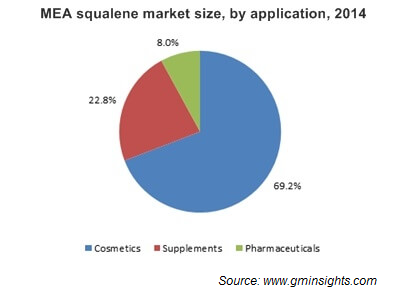Home > Chemicals & Materials > Biobased Chemicals > Biobased Chemical Intermediates > Squalene Market
Squalene Market Analysis
- Report ID: GMI380
- Published Date: Apr 2016
- Report Format: PDF
Squalene Market Analysis
Vegetable sources have dominated the squalene market share and are forecast to generate revenues well above USD 130 million by 2022. Olive oil is found to be the richest vegetable source for production and contains approximately 400 mg per 100 grams. Vegetable sources may see sizable gains, owing to limitations on deep water shark fishing and scaling issues for Amyris.
Shark squalene demand was pegged over 900 tons in 2014 with likely to witness lowest gains during forecast period. Shark liver oil is preferred by suppliers as they are inexpensive and contain in higher amounts in comparison to vegetable sources.
Cosmetics applications generally monopolize industry demand, with USD 65 million revenues in 2014. Key product uses include bath oils, hair preparations, eye makeup, suntan preparations, nail products, body powders, and cleansing, moisturizing and skin care preparations, with content ranging from 0.1% to 50%.
Dietary supplements may grow at over8.5% CAGR up to 2022 and exceed 1.1 kilo tons. Increasing consumer awareness for maintaining healthy lifestyle and avoid expensive medication should most likely boost the squalene market value for dietary supplement application.
Europe squalene market size, with major demand generated from cosmetic industries based in Germany, France and UK, was the predominant regional industry, with forecast of over USD 110 million revenue generation by 2022.
Increasing natural ingredients demand, especially plant derived, for personal care & cosmetic products by consumers owing to harmful effects from fossil fuel sources is most likely to fuel growth in Europe.
North America dominated by U.S was estimated to consume over 600 tons in 2014. Dietary supplement applications are likely to significantly grow among the U.S. consumer base
Asia Pacific led by China and India is likely to grow at significant pace over the next six years. Latin America, supported by strong growth indicators in Brazil, is relatively at a nascent stage with respect to consumption.

